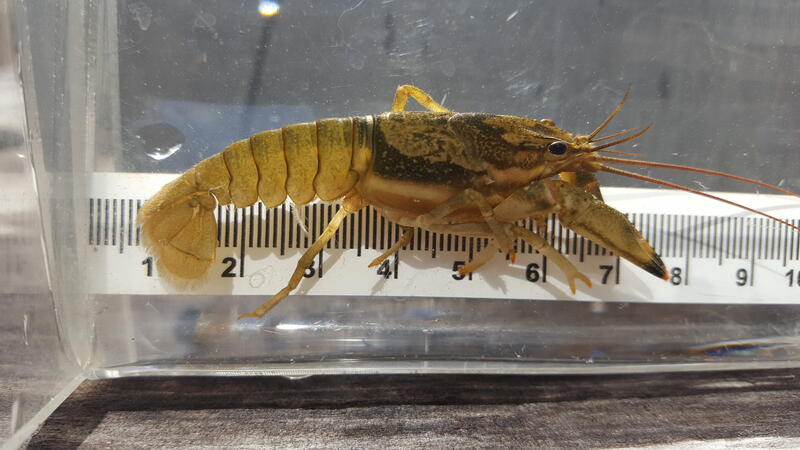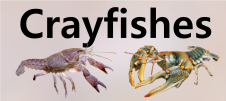







Loading profile. Please wait . . .
Faxonius durelli (Bouchard and Bouchard, 1995)
Saddle Crayfish




Federal Protection: No US federal protection
State Protection: No Georgia state protection
Global Rank: G5
State Rank: SNA
Element Locations Tracked in Biotics: No
SWAP 2015 Species of Greatest Conservation Need (SGCN): No
SWAP 2025 Species of Greatest Conservation Need (SGCN): No
2025 SGCN Priority Tier: None
Element Occurrences (EOs) in Georgia: 0
Habitat Summary for element in Georgia: Associated with rocks or woody debris in flowing and quiet areas of small streams to medium-sized rivers
As the name implies, there is dark pigment on the rear of the carapace which stretches forward along the upper sides as stripes, thus creating a u-shaped, saddle pattern. Below the dark lateral stripes are lighter (typically cream-colored) stripes, and below them, light to dark brown stripes. The abdomen is light brownish to greenish and there is a thin reddish line at the rear of each abdominal segment. The tips of the fingers of the claws are orange and there is black pigment just behind the orange tips. There are two rows of tubercles along the mesial margin of the palm. The rostrum is long, parallel-sided, and has a long, sharp acumen and marginal spines or tubercles. There is a single well-developed cervical spine. This species reaches a maximum total body length of about 70 mm (2.75 in). Note: Based on data presented by Crandall and De Grave (2017), this species was removed from the genus Orconectes and placed in Faxonius.
No other species that occur with Saddle Crayfish have such a striking striped color pattern along its sides.
The Saddle Crayfish is a stream dweller; in Georgia has been collected from flowing areas of small creeks with woody debris. In its native range, the species is found in a wide variety of habitats including flowing and calm waters in association with gravel, large rocks, leaf packs, and root mats along the margins of streams (Bouchard and Bouchard 1995).
No studies of this species are known. Crayfishes are considered opportunistic omnivores and likely feed on live and decaying vegetation, aquatic insect larvae, small fishes, and dead animal matter.
Bouchard and Bouchard (1995) reported male Saddle Crayfish in reproductive condition from January, and March through November. They reported females carrying eggs in March and April and one with young in April. Only non-reproductive males have been collected in Georgia thus far.
Kicking through woody debris or leaf packs into a seine or dip net may yield this species. Shocking downstream into a seine net with a backpack electroshocker is also effective.
The Saddle Crayfish is native to the Tennessee, Cumberland, and Green river systems in Alabama, Kentucky, and Tennessee. In Georgia, it has only been found in the Pettit Creek system which is a tributary to the Etowah River near Cartersville in Bartow County.
Since this species is not native to Georgia, no threats are recognized.
This species is not native to Georgia and should be considered invasive.
Educate local landowners and the general public about the threats posed by non-native species to natural ecosystems. Encourage the trapping of crayfishes in areas known to harbor invasive species and humanely destroy (by freezing) any non-native species encountered.
Bouchard, R.W., and J.W. Bouchard. 1995. Two new species and subgenera (Cambarus and Orconectes) of crayfishes (Decapoda: Cambaridae) from the eastern United States. Notulae Naturae, 471:1–21.
Crandall, K.A., and S. De Grave. 2017. An updated classification of the freshwater crayfishes (Decapoda: Astacidea) of the world, with a complete species list. Journal of Crustacean Biology 2017:1-39.
Taylor, C.A., G.A. Schuster, J.E. Cooper, R.J. DiStefano, A.G. Eversole, P. Hamr, H.H. Hobbs III, H.W. Robison, C.E. Skelton, and R.F. Thoma. 2007. A reassessment of the conservation status of crayfishes of the United States and Canada after 10+ years of increased awareness. Fisheries 32:372–389.
Christopher E. Skelton
C. Skelton, February 2019: original account
D.Weiler, October 2019: added photo